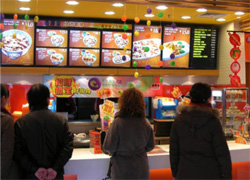Home > Highlighting JAPAN > Highlighting Japan FEBRUARY 2012 > Super Bowl
Highlighting JAPAN
COVER STORY: At Your Service
Super Bowl
Today, gyudon, or beef bowl, is so popular among Japanese that it could safely be declared Japan's national dish. The market for beef bowl has even spread overseas, to the United States, countries in Asia and elsewhere. Masaki Yamada reports on how this fast, cheap and delicious dish has been adapted to meet the needs of each country while preserving a universal level of service.

A branch of Yoshinoya in Dalian, China
Credit: COURTESY OF YOSHINOYA
Fast-forward to the 1970s, and companies offering gyudon as a form of fast food through chains began to appear. In the time since, gyudon has come to be widely enjoyed throughout Japan as a casual eating-out experience. Today, gyudon chain outlets from the likes of Sukiya, Yoshinoya, Matsuya and Nakau number more than 4,000 nationwide.
Of these, Yoshinoya boasts the longest history. In Japan, Yoshinoya's gyudon is known for its catchphrase, "fast, cheap, and delicious." While this sums up Yoshinoya in a nutshell, efforts to find and establish a system to achieve the "fast" and "delicious" aspects date back to the founding of Yoshinoya more than a century ago.
Yoshinoya was founded in 1899 at a fish market then located in the Nihonbashi district of Tokyo's Chuo Ward.
"It seems that everyone at the fish market really toughened up the staff at Yoshinoya back then," explains Haruhiko Kizu, manager of the PR section of Yoshinoya Holdings. "Due to the nature of their business handling food every day, the people who work at fish markets are quite strict about taste, and since they're busy while the market is still open, they won't form a line to get food. It was to meet these needs that the qualities of 'fast' and 'delicious' developed automatically, and have been carried on to this day."
The secret to "fast" lies in the characteristic U-shaped horseshoe design of Yoshinoya's counters. By limiting the menu options and having staff deal with each of the customers sitting around the outside of the counter from the inner space, wasteful traffic flows were eliminated and a speed of less than a minute from product order to serving was achieved. Further, narrowing down the kinds of ingredients and streamlining operations has also led to cheap prices.
The Growing Popularity of the American Store Style
Yoshinoya was the first Japanese company to start establishing gyudon restaurants overseas. In 1975 it opened its first such restaurant in Denver, USA, an area known as one of the world's leading producers of beef. But Americans did not immediately embrace Yoshinoya's style. Kizu describes the conditions at the time.
"The moderately bland flavor of the sauce was well received in the United States, but the horseshoe-shaped counter that had been so effective in Japan failed to take hold. This was because customers preferred a more extensive menu than in Japan, requiring additional work and storage space. In addition, since many customers would often visit in groups such as with family or friends, they sometimes couldn't sit together with horseshoe-shaped counter seating.
Given this, Yoshinoya switched to the walk-up-and-order system long employed at hamburger restaurants and other fast food outlets. This is a style where customers first place and pay for their order at the counter, then take their gyudon and drink to be eaten at their desired seating. The dishware used to serve the gyudon also changed. The bowls used in Japan were discarded in favor of foam containers. This allowed Yoshinoya to meet America's high demand for takeout products in a speedier fashion. In addition to the gyudon "beef bowl," a "chicken bowl" dish, not available in Japan, was added to the menu. A combo-bowl allowing customers to enjoy both beef and chicken has been most popular."
Yoshinoya has since expanded outside the United States to various countries and regions in Asia including China, Taiwan, Hong Kong, Singapore, the Philippines and Indonesia, and the reception has been positive.
"When we made our push into Asia we employed the American business model in terms of counter layout and menu items such as chicken bowls," notes Kizu.
Like a hamburger restaurant in the United States Yoshinoya outlets are popular as a form of fast food. In China and other Asian countries, on the other hand, Yoshinoya has a reputation as a place where one can enjoy a meal together with family or friends. In Hong Kong, Yoshinoya restaurants are also utilized as cafés outside lunch and dinner hours. "In the end, I think the Yoshinoya meals won acceptance because instead of being the same Japanese cuisine or fine multi-course dining, it could be enjoyed as a casual meal," says Kizu.
Yoshinoya opened its first store in Thailand in August 2011, and is focused on expanding its stores to untapped areas in China and various Southeast Asian countries moving forward. There are even designs for expanding operations to European countries. The day is fast approaching when the Japanese people's beloved gyudon can be eaten anywhere in the world.
© 2009 Cabinet Office, Government of Japan






